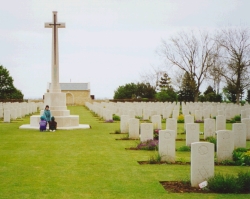Bény-sur-Mer Canadian War Cemetery

On June 6, 1944, now known to history as D-Day, Operation Overlord, the long-awaited invasion of Northwest Europe, began with Allied landings on the Coast of Normandy.
The 3rd Division and the 2nd Armoured Brigade were Canada's major ground contribution to the D-Day landings. These were representative of the whole nation: three of the infantry battalions came from Ontario, one from Quebec, three from the Western provinces and two from the Maritimes; the artillery, engineers, signals and service units were equally diverse in origins. The three regiments of the armoured brigade regiments represented Ontario, Manitoba and Quebec.
Under command of the British Second Army, supported by an impressive array of firepower from artillery, rocket-firing landing craft and naval guns, the Canadians stormed ashore at "Juno" beach, in the centre of the British sector, through rough water, beach obstacles, wire, mines and gunfire. By nightfall they had secured a beachhead, which, although short of the planned objectives, was firm enough to withstand enemy counter-attacks. In the days that followed the lodgement was strengthened and enlarged until by 11 June, the bridgehead was deemed secure enough to accommodate new formations that were to pour ashore in the next phase.
The cost in lives had been high, though not as high as had been estimated, and certainly not as high as it would have been without Dieppe. On D-Day alone, Canada suffered almost a thousand casualties, of whom 340 were killed or died of wounds. The list lengthened during the following days as the Germans sought desperately to drive the Allies out.
The men who fell on the beaches and in the bitter bridgehead battles are buried in Beny-sur-Mer Canadian War Cemetery which, despite its name, is near the village of Reviers. The cemetery contains 2,049 headstones enclosed by pines and maples. These mark the dead of the 3rd Division and the graves of 15 airmen. The mayor and people of Reviers take a special interest in the cemetery for, although it bears another name, they feel it to be their own. Fine hedges decorate the entrance, and the flanking registry buildings have platforms from which the visitor can see the whole area and appreciate the skill and devotion that has gone into the planning and design of this superb cemetery.
- Date modified: